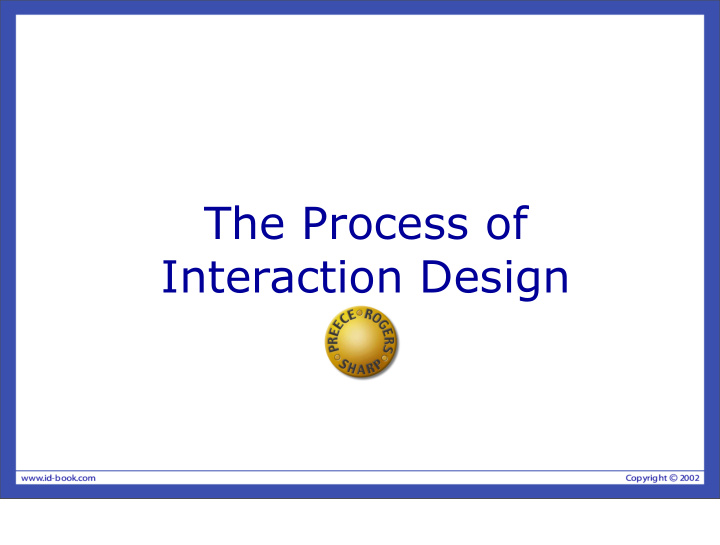



The Process of Interaction Design
Overview •What is Interaction Design? —Four basic activities —Three key characteristics •Some practical issues —Who are the users? —What are ‘needs’? —Where do alternatives come from? —How do you choose among alternatives?
What is Interaction Design? • It is a process: — a goal-directed problem solving activity informed by intended use, target domain, materials, cost, and feasibility — a creative activity — a decision-making activity to balance trade-offs • It is a representation: — a plan for development — a set of alternatives and successive elaborations
What is Interaction Design? (2) In interaction design, we investigate the artifact’s use and target domain by taking a user-centered approach to development. This means that users’ concerns direct the development rather than technical concerns. (ID 6.2)
Basic activities in ID 1. Identifying needs and establishing requirements 2. Developing alternative designs 3. Building interactive versions of the designs 4. Evaluating designs
Key characteristics of ID 1. Focus on users early in the design and evaluation of the artifact 2. Identify, document and agree specific usability and user experience goals 3. Iteration is inevitable. Designers never get it right first time
Some practical issues •Who are the users? •What are their ‘needs’? •Where do alternatives designs come from? •How do you choose among alternatives?
Who are the users? • Not as obvious as you think: — those who interact directly with the product — those who manage direct users — those who receive output from the product — those who make the purchasing decision •Three categories of user (Eason, 1987): — primary: frequent hands-on — secondary: occasional or via someone else — tertiary: affected by its introduction, or will influence its purchase
Who are the stakeholders? Check-out operators • Suppliers • Local shop owners Customers Managers and owners
What are the users’ capabilities? Humans vary in many dimensions: — size of hands may affect the size and positioning of input buttons — motor abilities may affect the suitability of certain input and output devices — height if designing a physical kiosk — strength - Winding up a child’s toy — disabilities(e.g. colorblind, tone-deaf at high frequencies)
What are ‘needs’? • Users rarely know what is possible • Users can’t tell you what they ‘need’ to help them achieve their goals • Instead, look at existing tasks: – their context – what information do they require? – who collaborates to achieve the task? – why is the task achieved the way it is? • Envisioned tasks: – can be rooted in existing behavior – can be described as future scenarios Taken from http://www.useit.com/ alertbox/20000917.html
What do we mean by needs’? “If a product is a new invention...” (ID p.173)
Where do alternatives come from? • Humans stick to what they know works • But considering alternatives is important to ‘break out of the box’ • Designers are trained to consider alternatives • How do you generate alternatives? —‘Flair and creativity’: research and synthesis —Seek inspiration: look at similar products or look at very different products • “We know, for instance...” (p.175)
IDEO TechBox • Library, database, website - all-in-one • Contains physical gizmos for inspiration From: www.ideo.com/
The TechBox Software gizmos?
How do you choose among alternatives? • Evaluation with users or with peers, e.g. prototypes • Technical feasibility: some not possible • Quality thresholds: Usability goals lead to usability criteria set early on and check regularly —safety: how safe? —utility: which functions are superfluous? —effectiveness: appropriate support? task coverage, information available —efficiency: performance measurements
Testing prototypes to choose among alternatives
Summary Four basic activities in the design process 1. Identify needs and establish requirements 2. Design potential solutions ((re)-design) 3. Choose between alternatives (evaluate) 4. Build the artifact These are permeated with three principles 1. Involve users early in the design and evaluation of the artifact 2. Define quantifiable & measurable usability criteria 3. Iteration is inevitable Lifecycle models show how these are related
Recommend
More recommend